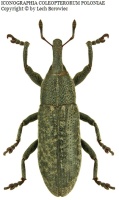
Русские, остановите эту войну! Спасите Свободную Украину!
Russians, stop this war! Save Free Ukraine!
Biodiversity Map
Taxa

Taxa selected by the filter:
Filter in use 
Taxon count: 1
-
Arthropodaphylum
Click to switch
to select orders
and filters > -
Hexapodasubphylum
Click to switch
to select orders
and filters > -
Insectaclass
Click to switch
to select orders
and filters > -
Coleopteraorder
Click to set
as the main taxon
and as a base
← of the left panel > -
Polyphagasuborder
Click to set
as the main taxon
and as a base
← of the left panel > -
Cucujiformiaseries
Click to set
as the main taxon
and as a base
← of the left panel > -
Curculionoideasuperfamily
Click to set
as the main taxon
and as a base
← of the left panel > -
Curculionidaefamily
Click to set
as the main taxon
and as a base
← of the left panel > -
Lixinaesubfamily
Click to set
as the main taxon
and as a base
← of the left panel > -
Lixinitribe
Click to set
as the main taxon
and as a base
← of the left panel > -
Lixusgenus
Click to set
as the main taxon
and as a base
← of the left panel > -
Dilixellussubgenus
Click to set
as the main taxon
and as a base
← of the left panel >
PL
YES
name status: valid name
BioMap ID: 1046892
taxon code: 5169
taxonomy checked: YES
Polish Red List: VU
-
Filter in use

- Views:
- Overview
- Records
- Publications
- Collections
- Bazy KSIB
- Publ. authors
- Illustrations
- Map
Data on distribution in Poland

Statistics
- Records: 45
- Publications: 29
- Collections: 3
- Publication authors: 29
- Illustrations (iconography): 1
- Photos (specimen/observation): lacking
Taxon description
Gatunek rozmieszczony w basenie Morza Śródziemnego i w środkowej części Europy, na wschód docierający do Kaukazu i Azji Mniejszej. W Polsce ryjkowiec ten należy do rzadkości — notowano go z nielicznych stanowisk w tylko pięciu krainach położonych w zachodniej i południowej części kraju, przy czym większość danych o jego występowaniu opiera się na znaleziskach sprzed 1910 roku. Zasiedla mokre łąki, rowy, zarośla, przydroża i żwirowiska. Jako rośliny żywicielskie tego gatunku były podawane w piśmiennictwie: starzec wodny — Senecio aquaticus Huds., starzec Jakubek — S. jacobaea L., pępawa dwuletnia — Crepis biennis L. i gorczycznik pospolity — Barbaraea vulgaris R. Br. Postacie dojrzałe poławiano od kwietnia do września. Larwy żyją w szyi korzeniowej i dolnej części łodygi, odżywiając się tkankami rdzenia; przed przepoczwarzeniem robią komorę poczwarkową z włókien żerowiska.
Illustrations
... browse
 Lixus
Lixuspunctiventris
External data sources
- Ostatnie rekordy
-
1112844
 ⊡
⊡ Curculionidae: Lixus punctiventris, PL, Wyżyna Małopolska, Chęciny, UTM DB62, 2011, leg. C. Nowak
Curculionidae: Lixus punctiventris, PL, Wyżyna Małopolska, Chęciny, UTM DB62, 2011, leg. C. Nowak -
799545
 ×
× Curculionidae: Lixus punctiventris, PL (Kubisz et al. 1998b)
Curculionidae: Lixus punctiventris, PL (Kubisz et al. 1998b) -
799544
 ×
× Curculionidae: Lixus punctiventris, PL (Soszyński et al. 2008)
Curculionidae: Lixus punctiventris, PL (Soszyński et al. 2008) -
799543
 ×
× Curculionidae: Lixus punctiventris, PL (Petryszak 2003)
Curculionidae: Lixus punctiventris, PL (Petryszak 2003) -
799542
 ×
× Curculionidae: Lixus punctiventris, PL (Mazur 1994d)
Curculionidae: Lixus punctiventris, PL (Mazur 1994d) -
799541
 ×
× Curculionidae: Lixus punctiventris, PL (Petryszak 1998b)
Curculionidae: Lixus punctiventris, PL (Petryszak 1998b) -
799540
 ×
× Curculionidae: Lixus punctiventris, PL (Stachowiak 1999(1998))
Curculionidae: Lixus punctiventris, PL (Stachowiak 1999(1998)) -
740980
 ×
× Curculionidae: Lixus punctiventris, PL (Stachowiak 1999(1998))
Curculionidae: Lixus punctiventris, PL (Stachowiak 1999(1998)) -
576581
 ⊡
⊡ Curculionidae: Lixus punctiventris, PL, Wyżyna Małopolska, świętokrzyskie, Chęciny ad Kielce, UTM DB62, 2007, leg. M. Wanat
Curculionidae: Lixus punctiventris, PL, Wyżyna Małopolska, świętokrzyskie, Chęciny ad Kielce, UTM DB62, 2007, leg. M. Wanat -
576404
 ⊡
⊡ Curculionidae: Lixus punctiventris, PL, Wyżyna Małopolska, Przedborski P.K., świętokrzyskie, Dobromierz, UTM DB25, 2007, leg. M. Wanat
Curculionidae: Lixus punctiventris, PL, Wyżyna Małopolska, Przedborski P.K., świętokrzyskie, Dobromierz, UTM DB25, 2007, leg. M. Wanat - ... more
- Powiązane publikacje
-
Soszyński B., Kowalczyk J.K., Mielczarek Ł, Mocarski Z., Osicki T., Sobczak S. 2008. Owady. [In:] Wnuk Z. (Ed.) Przedborski Park Krajobrazowy, 20 lat istnienia PPK (1988-2008). pp. 140-153.
 Show records
Show records -
Petryszak B. 2003. Pędrusie i ryjkowce. [In:] Górecki A., Krzemień K. (Eds.) Przyroda Magurskiego Parku Narodowego. pp. 101-112.
 Show records
Show records -
Stachowiak P. 1999(1998). Obserwacje nad występowaniem w Polsce ryjkowców z rodzaju Lixus Fabricius, 1801 (Coleoptera: Curculionidae). Wiad. Entomol., 17(3-4):183-187.
 full text
full text Show records
Show records -
Petryszak B. 1998b. Ryjkowce (Coleoptera, Curculionidae) Bieszczad Wysokich. Studia Ośr. Dok. Fizj., 25:89-135.
 Show records
Show records -
Kubisz D., Kuśka A., Pawłowski J.S. 1998b. Czerwona lista chrząszczy (Coleoptera) Górnego Śląska. [In:] Centrum Dziedzictwa Przyrody Górnego Śląska Raporty Opinie Tom 3. Katowice. pp. 8-68.
 Show records
Show records - ... more
- Powiązane zbiory
-
ISEZ PAN
 Show records
Show records -
Wanat M.
 Show records
Show records -
Komosiński K.
 Show records
Show records
- Wykaz powiązanych pozycji
-
Curculionoidea of Poland
 Show records
Show records






